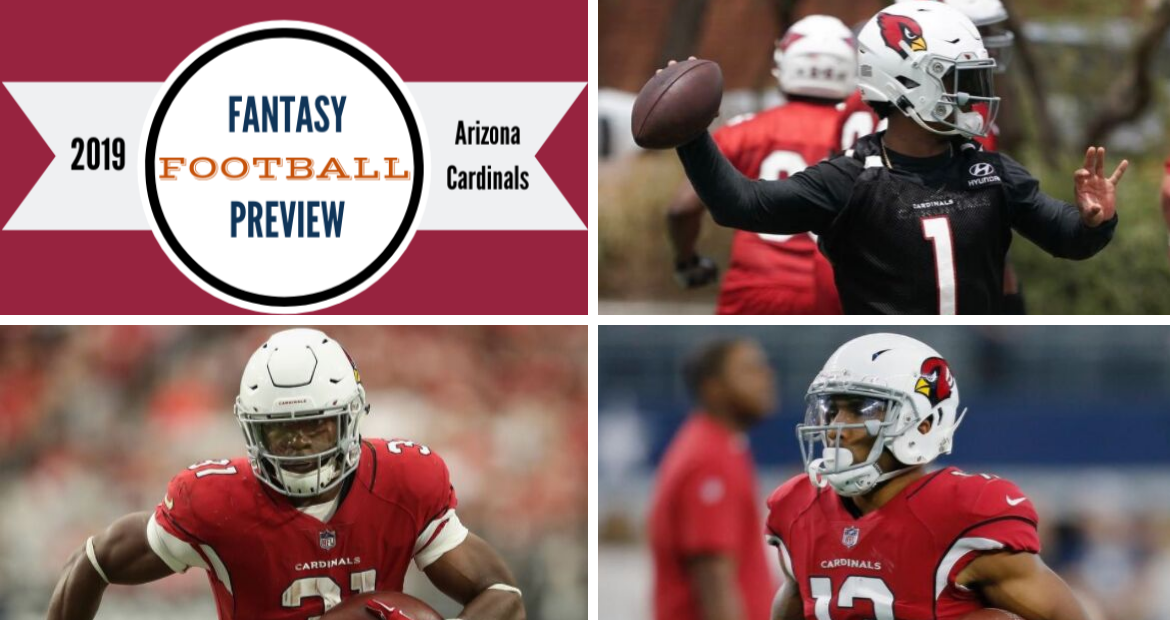
Fitz on Fantasy: 2019 Arizona Cardinals Buying Guide
With the preseason nearing, TFG fantasy expert Pat Fitzmaurice is breaking down the prospects for all 32 teams. Click here for a running list of teams, and check back often as teams are added on an almost daily basis. On to the Arizona Cardinals…
It’s refreshing to see people excited about the Cardinals’ offense again. Arizona was fun to watch for most of the Bruce Arians era, but the Steve Wilks era – all 344 days of it – was kind of a drag.
Much of the blame for the Cards’ 2018 offensive woes belongs to offensive coordinator Mike McCoy, who was unable to get one of the best pass-catching backs in the league involved in the passing game and instead slammed him in between the tackles, where there was no room to maneuver because the Arizona offensive line couldn’t punch a hole through a cardboard box. When McCoy was fired after a Week 7 loss to the Broncos, Arizona ranked 32nd in rushing yards, 31st in passing yards and 31st in points per game.
Showing up to an NFL game with Mike McCoy as your offensive coordinator was like showing up to a knife fight with a knockwurst.
The team replaced Wilks with a fascinating hire: Kliff Kingsbury, who turned 40 shortly after taking the job. Kingsbury was fired as Texas Tech’s head coach in November after posting a 35-40 record over six seasons, but he was immediately hired as USC’s offensive coordinator, and Sean McVay had wanted to add him to the Rams’ staff.
Kingsbury used to play for Mike Leach, who created the Air Raid offense. Kingsbury used similar spread concepts at Texas Tech and will undoubtedly use some in Arizona. The Cardinals’ offense will probably operate at a hastened tempo, and we can expect the Cards to use the shotgun formation on most snaps.
But will the offense be any good?
The obvious comparisons for Kingsbury are Steve Spurrier and Chip Kelly, who ran wide-open (and wildly successful) schemes at the college level before moving to the NFL. Spurrier’s 2002-2003 Redskins went 12-20 and finished no better than 22nd in points per game or yards per play in those two years. When Kelly made his NFL debut in 2013, his Eagles finished first in yards per play and third in points. Kelly’s offense was slightly less effective but still good in 2014, roughly league-average in 2015, and then the wheels came off in 2016, by which point Kelly had denuded Philadelphia’s roster with a series of terrible personnel decisions.
The Cards would seem to have the skill-position talent to make Kingsbury’s offense work after loading up in the draft. The big concern is an offensive line that gave up 52 sacks in 2018 and ranked 25th in Football Outsiders’ adjusted line yards run-blocking metric. A mobile quarterback and a passing scheme predicated on quick releases can put a layer of mascara on the offensive line problem, but the Kingsbury offense might not flourish until the blocking gets a full makeover.
Kyler Murray is one of the more intriguing fantasy commodities of 2019. The Cardinals moved up to the No. 1 pick so that Murray could be the triggerman in Kingsbury’s offense, then discarded last year’s first-rounder, Josh Rosen, as if he were a chicken bone.
Murray’s final season at Oklahoma was the second most efficient season by a college quarterback in history, behind only Tua Tagovailoa’s season for Alabama last year. (Baker Mayfield’s final season at Oklahoma in 2017 was third.) Murray also runs like a jackrabbit, weaving through traffic like Ryan Gosling’s character in “Drive.” That combination of passing acumen and rushing ability has some fantasy owners giddy, but the jump from college to the NFL will test Murray’s passing efficiency, and it’s fair to wonder about the physical well-being of a 5-10, 207-pound quarterback who’ll be protected by an offensive line made of cheesecloth.
In a traditional one-QB league with 10 or 12 teams, I’m happy to draft Murray above his QB11 ADP because it will be easy enough to find a replacement if things don’t work out. I’ll be slightly more cautious in 2QB leagues, superflex leagues, and leagues with 14 or 16 teams – but I’ll still be very interested in buying.
Murray’s primary backup is Brett Hundley, who was a train wreck when he filled in for the injured Aaron Rodgers two seasons ago in Green Bay, throwing more interceptions (12) than TD passes (9) and averaging 5.8 yards per pass attempt. Still, with this being a potentially interesting offense and with Murray so slight of build, it’s worth remembering Hundley’s name.
The David Johnson undertow dragged a lot of fantasy owners beneath the surface last year. A lousy system and a paucity of play volume churned the waters, but poor offensive line play added to the rip current, too.
Johnson averaged 3.6 yards per carry and was asked by Mike McCoy to repeatedly take inside handoffs, which is like going to Le Bernardin for a meal and asking Eric Ripert and his staff to make you a tuna melt. Johnson’s average depth of target was 1.8 yards, an obscenely low total for a running back with exquisite pass-catching skills and another sign that McCoy didn’t have a clue. The David Johnson who totaled 2,118 yards from scrimmage and 20 touchdowns in 2016 is eager to whip up a multi-course tasting menu, and Kingsbury’s offense should provide the mise en place that Chef DJ needs.
He’s a tier below the “Big Four” of Christian McCaffrey, Saquon Barkley, Ezekiel Elliott and Alvin Kamara, but Johnson sits atop the next tier at RB5.
Chase Edmonds should be the clear backup to Johnson. The Cards took him in the fourth round of the 2018 draft, drawn in by his above-average athleticism and the freaky numbers he put up at Fordham during his first three seasons there. Edmonds is one of my favorite late-round flyers in best-ball leagues and in other deep drafts because he could become hugely valuable if anything were to happen to DJ.
Christian Kirk turned in a credible rookie-year performance in 2018 despite the miasma around him, catching 43 passes for 590 yards and three TDs in 12 games before breaking his foot. There’s a lot to like with Kirk. He had 80 catches for 1,009 yards as an 18-year-old freshman at Texas A&M and had been recruited by Kingsbury while in high school. He can line up outside or in the slot. He has good speed and is considered a good route runner.
The market is fond of the second-year receiver. His current ADP is WR34 and climbing. It’s a good price for an ascendant receiver, but as with many of the Cardinals’ fantasy assets, I’m worried about a market bubble once the Arizona offense is unveiled in the preseason and fantasy owners get excited about what they see.
Noble old warhorse Larry Fitzgerald is entering what might be his final season. Who can blame him for not wanting to go out on such a sour note? Fitz has aged well, and while his 69-734-6 stat line in 2018 didn’t do much for his fantasy owners, the overall dysfunction of the offense might have tricked some people into believing Fitz has tumbled over the age cliff.
Don’t bet on it.
The big-play upside is gone, but Fitz could still catch a lot of balls in an uptempo spread attack. I’m not going to say he’s a steal at an ADP of WR38 – the limited ceiling he’ll have in his age-36 season has to be factored in – but Fitz is a solid bet to return a profit at that cost.
Andy Isabella was one of the more intriguing prospects in this year’s draft. He’s only 5-9 and 188 pounds, he’s a body-catcher, and he played against so-so competition at U-Mass. But with legitimate 4.3 speed, Isabella could beat Hermes in a footrace. He had 102 catches for 1,698 yards and 13 touchdowns in his final college season, which included a monstrous performance in a road loss at Georgia – 15 catches, 219 yards, two touchdowns. Isabella has been another late-round favorite of mine.
A lot of draft analysts LOVED Hakeem Butler of Iowa State, but NFL general managers let him slide all the way to Day 3 of the draft before Arizona finally took him with the first pick of the fourth round. Butler is 6-5, 227 pounds, and he combines the wingspan of a pterodactyl with sub-4.5 speed. He averaged 22.0 yards per catch in his final season in Ames. The knocks on him are that he was just a one-year producer in college, he’s drop-prone, and that he might not have enough quickness to get separation at the NFL level. I like Butler longer-term but don’t see him as a draftable asset this year.
Other Cardinals receivers worth monitoring in August: rookie sixth-rounder KeeSean Johnson from Fresno State, brittle former Bears first-round pick Kevin White, and athletic third-year man Chad Williams.
Ricky Seals-Jones is an intriguing TE sleeper. He’s 6-5 and runs well, he’s shown flashes of playmaking ability over the last two years – and, like Kirk, he was once recruited by Kingsbury. But the Cardinals added Charles Clay in the offseason, and it’s unclear what sort of role the tight ends will play in this offense. Seals-Jones isn’t draftable in most leagues but could be a guy who ends up on a lot of rosters during the season. Less interesting is the oft-injured Clay, who’s now 30 and has averaged under 10 yards per catch in two of the last three seasons.
| PLAYER | FITZ RANK | ECR | ADP | ADVICE |
| Kyler Murray | QB9 | QB15 | QB11 | Worthy risk |
| David Johnson | RB5 | RB5 | RB5 | Buy confidently |
| Chase Edmonds | RB47 | RB68 | RB72 | Possible flyer |
| Christian Kirk | WR32 | WR37 | WR34 | Good value |
| Larry Fitzgerald | WR37 | WR41 | WR38 | Age discount |
| Andy Isabella | WR58 | WR82 | WR65 | Watch list |
| Ricky Seal-Jones | TE35 | TE30 | TE38 | Long shot |
ADP = Average Draft Position ECR = Expert Consensus Ranking (based on half-PPR scoring)



